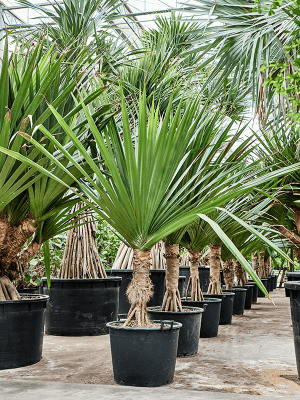
Pandanus utilis (260-300)
Stem
4PAUTRS07
Pandanus or Pandan is one of the most curious tropical shrubs or trees in existence. The tree's leaves are reminiscent of yucca, but the Pandanus also resembles a Mangrove due to the many prop roots around its trunk. Pandanus leaves have a nutty flavour and are a popular condiment fresh or dried in Indonesian and Thai dishes, such as pandan cake or spekkoek. Pandanus leaves are also used for making a tasty thirst-quenching tea and weaving baskets and mats, among other things. In addition, the leaf of a Pandanus is said to have an anti-inflammatory effect and helps heal various tropical discomforts. In short, a Pandanus is at home in all markets.
The Pandanus or Pandan plant is an evergreen tree that grows in the tropical regions of Southeast Asia and Oceania. The tree is also known as the screw palm, which can be easily explained by looking at the spirally woven leaves in threes. The thick prop roots around the trunk of the Pandanus anchor themselves firmly in the (sandy) soil and offer the tree support when it becomes top-heavy with branches, leaves and fruit or in strong winds. The species vary from small shrubs that grow up to 1 meter in height to medium-sized trees of up to 20 meters.

Although the Pandanus loves the heat, the leaves will burn if placed in full sun. The screw palm thrives in a light, semi-shaded spot, where the plant receives a maximum of 3 to 5 hours of direct sunlight. It is best to place the plant in front of a north-facing window, or 2 to 3 meters from an east or west window. When determining the location, also consider the foot traffic because the leaves will get unsightly spots if touched frequently.
Due to the tropical origin of the Pandanus, the plant is used to high humidity. Therefore, make sure that the soil is always slightly moist. It's best to water it a little at a time or ensure the excess water can drain off to prevent root rot. We also advise you to water the Pandanus with lukewarm water because the plant does not like cold water.
It's best to spray the plant regularly to keep the screw palm in good condition. This maintains humidity, promotes the plant's health, and protects it against pests. This should preferably be done with rainwater or decalcified water to prevent lime spots on the leaves. In addition to high humidity, it is important to optimise the ambient temperature. The Pandanus doesn't overheat easily. The plant thrives between 18-22°C during the day and 15-18°C at night.
A Pandanus does not need to be pruned, but withered leaves are best cut about 3 centimetres from the trunk to prevent fungal infections.
During the spring and summer season, extra feeding will help the Pandanus grow new leaves. Consult the plant nutrition packaging for the recommended quantities and frequency of feeding. The screw palm does not need additional nutrition in the autumn and winter months.

The genus Pandanus consists of about six hundred species. The Nieuwkoop Europe range includes Pandanus utilis and Pandanus tectorius.
The best-known screw palm is Pandanus utilis, which can grow to about 6 meters. This variant has long sword-shaped leaves, the edges of which grow single thorns. The leaves grow in a spiral. Pandanus utilis is dioecious, meaning there are male and female plants. The male plant has fragrant flowers, and the female plant has non-scented flowers that develop into pineapple-like fruit consisting of many small drupes. These are edible but not particularly tasty.
The Pandanus tectorius, also known as the scented screw palm, can grow up to 10 m high. The characteristic support roots anchor the tree firmly in the ground. The leaves are usually 90-150 cm long and 5-7 cm wide and have a serrated edge. The ripe fruits of a Pandanus tectorius are round, up to 25 cm in diameter, orange, healthy and tasty. They can be eaten raw or cooked.
